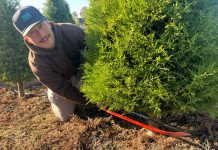Mining company moves forward with state permits to remove 150
redwoods while county determines whether plan violates
clear-cutting ordinance
The fate of some 150 coastal redwood trees is hanging as Granite
Rock moves ahead with state permits to remove them and supervisors
study whether the giants are covered by the county’s new ban on
clear cutting.
Mining company moves forward with state permits to remove 150 redwoods while county determines whether plan violates clear-cutting ordinance
The fate of some 150 coastal redwood trees is hanging as Granite Rock moves ahead with state permits to remove them and supervisors study whether the giants are covered by the county’s new ban on clear cutting.
Granite Rock wants to widen its main Wilson Quarry near Aromas, but to do so the company must chop down about 150 redwoods – some as old as 100 years – that reside in a nine-acre swath between the pit and the Pajaro River.
The plan has “green” Supervisor Ruth Kesler – no stranger to battles with the company and its quarry operations in her District 2 – seeing red.
“There’s a hole big enough there to put San Juan Bautista in,” said Kesler at Tuesday’s board meeting. “I can’t see Granite Rock clear-cutting all those redwood trees just to be able to get a few more pounds of dirt.”
Kesler and other supervisors believe the plan may violate a new local ordinance enacted last summer that bans clear-cutting. The ordinance was in reaction to Pacific Gas & Electric’s removal of hundreds of privately owned heritage oak trees in the San Juan hills under the company’s power lines.
The supervisors voted to take no action on Granite Rock’s plan, but it doesn’t mean they won’t sometime in the future.
Granite Rock spokesman Jim West said the company could be exempt from the clear-cutting ordinance because the county approved the company’s mine reclamation plan for the quarry in 1980, which stated that Granite could cut redwoods as long as they were at least 200 feet above sea level. The Wilson Quarry is “grandfathered” in, he said, and added that the company will replace all the trees at a 6.25-1 ratio. In other words, for every 100 trees destroyed the company will replant 625.
“They knew what we were going to do 20 years ago,” said West. “It seems unfair that the county would create a new law that takes away the rights they granted us 20 years ago. However, if the county says we have to go through it, we’ll go through it.”
“I would feel bad if the action reduced the number of healthy viable redwood trees in the state,” West added. “But we will create more habitat than we will destroy.”
Standing on the road above the quarry, with the 250-acre, 500-foot-deep open quarry pit on one side and a steep, 75-degree slope of redwoods and other flora on the other, West pointed to some of the trees closest to the road and noted their scraggly condition. The tree trunks had been buried up to 10 feet by overburden from the quarry road, which caused them to lose upper branches and leaves. But they were still alive. Almost all of the trees were tagged with orange ribbons, meaning “removal.”
“Waste rock is killing the trees next to the road,” said West.
At the bottom of the redwood canyon beneath the road, another grove of healthy redwoods grows next to the Pajaro River. None of those would be touched, said West. He didn’t think the tree removal would be visible from Highway 129, which rolls along the opposite side of the Pajaro.
“We have to face this with both the state and the county,” said West. “But we own thousands of acres around here and we can plant trees anywhere, except on top of rocks. We can plant as many trees as the county wants us to.”
Granite Rock hired biologists and experts six months ago in preparation for the project. One of them, forester Bill Zaughn of the Felton-based Staub Forestry consultant group, said the redwoods in question are in bad shape and added that 99 percent of the redwoods in that area are being retained.
“Most of them, frankly, are in pretty declining condition,” said Zaughn.
West also said that in 1985 the state designated the Wilson Quarry as “an important mineral resource to the region and the state,” and that the distinctive title could weigh in favor when the state considers the rock company’s applications for a timber harvesting permit and a timber conversion permit early next year.
“It doesn’t mean it will override environmental factors,” said West. “It doesn’t give us any particular rights. But if that land had no other value than the trees then the state could say they’re not going to let us take the trees off, no matter how many we plant. But it does mean the state has recognized that here is a mineral deposit there that is of regional significance to the state economy.”
Though Granite Rock has yet to complete a full-blown environmental review of the plan, the company hired Dana Bland & Associates and the Biotic Resources Group, two environmental consultants, to check out possible impacts that the cutting could cause.
“It’s pretty little,” said Bland. “Most of those redwoods are thin looking.”
But Bland’s crew is suggesting that if the rock company goes ahead with the redwood removal that they hire a qualified bat biologist to place “exclusionary devices” in the tree hollows before the trees are removed so that bats and birds won’t nest in them. The timing of the chain-sawing plan is crucial too. They would have to do it between August and January, the off-season for mating and the on-season for migration.
Bland said she also had some concern for tree-nesting raptor birds such as Red Tailed Hawks, Cooper’s Hawks and owls.
“The Cooper’s Hawk is a Species of Special Concern, and a secretive species,” said Bland. “They could abandon the nest if there’s too much noise or if their visual camouflage is disturbed.”
Another species that could be impacted by the redwood removal is the San Francisco dusky-footed woodrat, which makes large nests of twigs in and around the bases of the trees.
Granite Rock has replanted thousands of trees as part of its state-mandated reclamation efforts and enlists the help of local Boy Scouts and 4-H members, who have gathered and planted hundreds of Live Oak, redwood and other native tree seeds from their quarry areas. The efforts have been most successful at the Southside plant near Tres Pinos.
At Tuesday’s meeting, Kesler suggested that Granite Rock abandon the tree-cutting plan, at least for five or six years.
Supervisor Richard Scagliotti asked County Counsel Karen Forcum whether the issue falls under the new clear-cutting ordinance. She said it did, and that Granite Rock’s plan will be subject to county review.
“We don’t have any control over when they apply for a permit, so it’s a moot point,” said Scagliotti.
He suggested the board take no action and members complied.
After the meeting, when asked if he thought the Wilson Quarry was exempt from the county’s clear-cutting ban because of a grandfather clause, Scagliotti was adamant.
“There’s no grandfathering it in,” he said. “Then everything would be exempt.”
County Planning Director Rob Mendiola said he would have to look into the case further to be able to comment on it.
West saw the predicament in a bigger context.
“Don’t forget, there are over 300 families in San Benito County that depend on Granite Rock for harvesting that site,” he said. “There are trees that have been there 100 years, but this quarry has been here 110 years. We’ve replanted redwood trees both at the Wilson quarry and at the Southside quarry in Tres Pinos and we know through our own experience that we can re-establish redwoods.”









